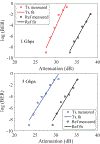Indium Phosphide Photonic Integrated Circuits for Free Space Optical Links
- PMID: 30416332
- PMCID: PMC6219397
- DOI: 10.1109/JSTQE.2018.2866677
Indium Phosphide Photonic Integrated Circuits for Free Space Optical Links
Abstract
An indium phosphide (InP)-based photonic integrated circuit (PIC) transmitter for free space optical communications was demonstrated. The transmitter consists of a sampled grating distributed Bragg reflector (SGDBR) laser, a high-speed semiconductor optical amplifier (SOA), a Mach-Zehnder modulator, and a high-power output booster SOA. The SGDBR laser tunes from 1521 nm to 1565 nm with >45 dB side mode suppression ratio. The InP PIC was also incorporated into a free space optical link to demonstrate the potential for low cost, size, weight and power. Error-free operation was achieved at 3 Gbps for an equivalent link length of 180 m (up to 300 m with forward error correction).
Keywords: Free space communication; Mach-Zehnder modulator; optical interconnect; photonic integrated circuit; sampled grating DBR laser; semiconductor optical amplifier.
Figures















References
-
- Hemmati H, Biswas A, and Djordjevic IB, “Deep-space optical communications: future perspectives and applications,” Proceedings of the IEEE, vol. 99, no. 11, pp. 2020–2039, Nov. 2011.
-
- Caplan DO, “Laser communication transmitter and receiver design,” J. Opt. Fiber Commun. vol. 4, pp. 225—362, 2007.
-
- Kingsbury RW, Caplan DO, and Cahoy KL, “Compact optical transmitters for Cubesat free-space optical communications,” Proc. of SPIE, Free-Space Laser Communication and Atmospheric Propagation, 2015, pp. 9354.
-
- Cesarone RJ, Abrahams DS, Shambayati S, and Rush J, “Deep space communications visions trends and prospects”, in Proc. Int. Conf. Space Opt. Syst. Appl., 2011, pp. 412–425.
-
- Rosborough V, Gambini F, Snyder J, Johansson L, and Klamkin J, “Integrated transmitter for deep space optical communications,” in Proc. Conf. IEEE Avionics and Vehicle Fiber-Optics and Photonics (AVFOP), 2016, pp. 207–208.
Grants and funding
LinkOut - more resources
Full Text Sources
Other Literature Sources
Miscellaneous
